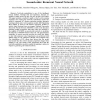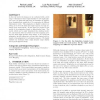3322 search results - page 333 / 665 » Automatic Human Model Generation |
ICML
2009
IEEE
16 years 13 days ago
2009
IEEE
This paper describes an unsupervised learning technique for modeling human locomotion styles, such as distinct related activities (e.g. running and striding) or variations of the ...
115
click to vote
IROS
2009
IEEE
15 years 6 months ago
2009
IEEE
— Tool-body assimilation is one of the intelligent human abilities. Through trial and experience, humans are capable of using tools as if they are part of their own bodies. This ...
GECCO
2007
Springer
15 years 3 months ago
2007
Springer
A primary goal of evolutionary robotics is to create systems that are as robust and adaptive as the human body. Moving toward this goal often involves training control systems tha...
118
click to vote
AFRIGRAPH
2004
ACM
15 years 5 months ago
2004
ACM
In the real world, the human eye is confronted with a wide range of luminances from bright sunshine to low night light. Our eyes cope with this vast range of intensities by adapta...
IADIS
2004
15 years 1 months ago
2004
Inductive reasoning is one of the important characteristics of human intelligence. Researchers have regarded inductive reasoning as one of the seven primary mental abilities that ...


